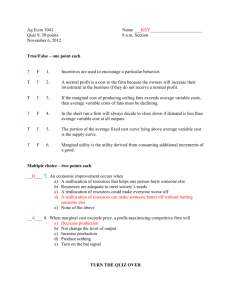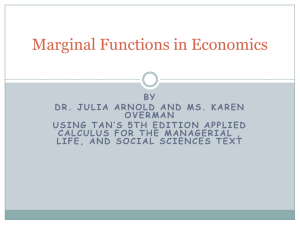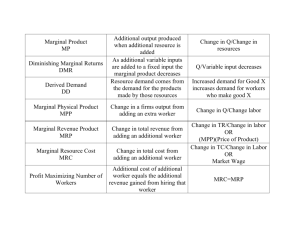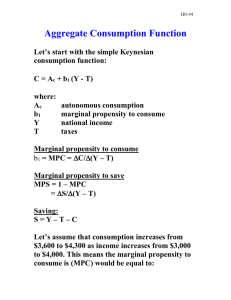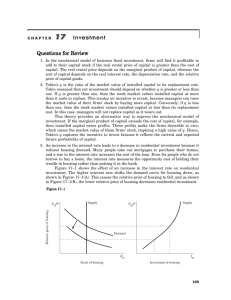Test 1 solutions (Spring 2009)
advertisement
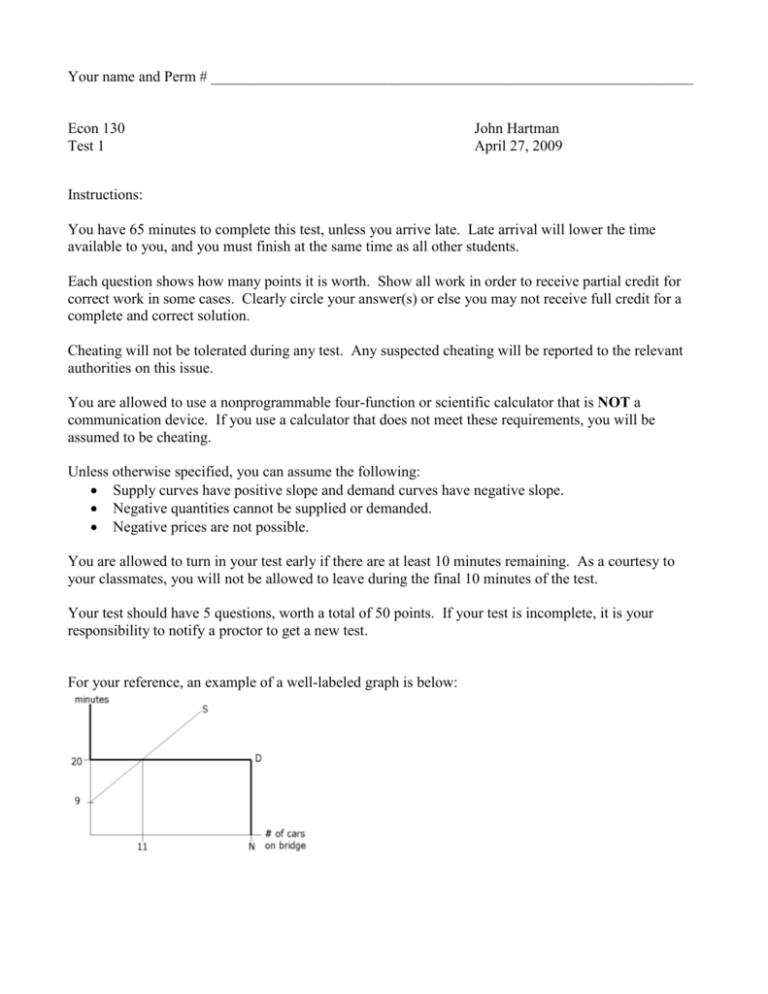
Your name and Perm # ________________________________________________________________ Econ 130 Test 1 John Hartman April 27, 2009 Instructions: You have 65 minutes to complete this test, unless you arrive late. Late arrival will lower the time available to you, and you must finish at the same time as all other students. Each question shows how many points it is worth. Show all work in order to receive partial credit for correct work in some cases. Clearly circle your answer(s) or else you may not receive full credit for a complete and correct solution. Cheating will not be tolerated during any test. Any suspected cheating will be reported to the relevant authorities on this issue. You are allowed to use a nonprogrammable four-function or scientific calculator that is NOT a communication device. If you use a calculator that does not meet these requirements, you will be assumed to be cheating. Unless otherwise specified, you can assume the following: Supply curves have positive slope and demand curves have negative slope. Negative quantities cannot be supplied or demanded. Negative prices are not possible. You are allowed to turn in your test early if there are at least 10 minutes remaining. As a courtesy to your classmates, you will not be allowed to leave during the final 10 minutes of the test. Your test should have 5 questions, worth a total of 50 points. If your test is incomplete, it is your responsibility to notify a proctor to get a new test. For your reference, an example of a well-labeled graph is below: 1. Assume that you are working for a company that can do one of two projects: The first project has a cost of $1000 and a benefit of $200 this year. Next year, the cost is $500 and the benefit is $1500. The second project has a cost of $600 and a benefit of $0 this year. Next year, the cost is $100 and the benefit is $850. Assume no inflation. (Note: All of the credit for this problem will be for justifying your answers. Show all work or you will receive no credit.) (a) (2 points) If the annual discount rate is 0%, which project would you recommend doing? Project 1: Total benefit is $200 + $1500 = $1700; total cost is $1000 + $500 = $1500; PV is $1700 – $1500 = $200. Project 2: Total benefit is $0 + $850 = $850; total cost is $600 + $100 = $700; PV is $850 – $700 = $150. Pick Project 1, since it has a higher PV. (b) (4 points) What is the benefit-cost ratio of each project when the annual discount rate is 10%? Project 1: TB is $200 + ($1500 / 1.1) = $1563.64 TC is $1000 + ($500 / 1.1) = $1454.55 TB / TC = 1.075 Project 2: TB is $0 + ($850 / 1.1) = $772.73 TC is $600 + ($100 / 1.1) = $690.91 TB / TC = 1.118 (c) (3 points) If the annual discount rate is 10%, which project would you recommend doing? Using the information in (b)… Project 1: TB – TC = $109.09 Project 2: TB – TC = $81.82 Pick Project 1 (d) (3 points) For what annual discount rate would the company be indifferent between the two projects? Find r such that –800 + (1000 / (1+r)) = –600 + (750 / (1+r)). This is equivalent to 250 / (1+r) = 200, which means r is .25, or 25%. 2. Assume your utility function is U(x) = log10(x), with x in dollars. For parts (b)-(d): Assume that you have a 20% probability of a $100 payout and an 80% probability of a $10,000 payout. (a) (1 point) What is your utility if you received $10,000 with certainty? U(10,000) = log10(10,000), or 4. (b) (3 points) What is the expected income of this gamble? Expected income is .2 (100) + .8 (10,000) = $8,020. (c) (3 points) What is the expected utility of this gamble? EU = .2 log10(100) + .8 log10(10,000) = 3.6. (d) (4 points) What is the certainty equivalent of the gamble? C.E. = 103.6 = $3,981.07. 3. Assume that three people are potential demanders of a particular good (x denotes quantity of the good): Person A has a marginal benefit of 500 – 20x. Person B has a marginal benefit of 200 – 2x. Person C has a marginal benefit of 400 – 10x. The marginal cost of the good is 10. (a) (4 points) How many units of the good are purchased in if this is a private good? Assume a competitive market. Person A: 500 – 20x = 10 x = 24.5 Person B: 200 – 2x = 10 x = 95 Person C: 400 – 10x = 10 x = 39 Total is 24.5 + 95 + 39 = 158.5 (b) (5 points) How many units of the good are provided in an efficient outcome if this is a public good? There are many ways to solve this problem. If you graphed the three marginal benefit curves, you will see that only Person B has a positive MB for quantities above 40. At Q = 40, Person B’s MB is 120, which is higher than the MC for an additional unit. So Person B’s MB curve above 40 is the only portion of the collective demand that we need to determine the efficient provision. (If you are having trouble seeing this, look back at Figure 4.4, p. 59) Set 200 – 2x = 10 x = 95 (Note: If you just did vertical summation and set MPB = MC to solve for quantity, you would have received 2 points if you did it correctly.) 4. The government is planning how much to spend for a new project. Assume that spending on the project is y dollars. The total benefit of the project to society is 6,000y2/3. (a) (5 points) What is the efficient level of spending on the project? First, find MB and MC: MB is the derivative of total benefit with respect to y: 4,000 / y1/3 MC is the derivative of total cost with respect to y: 1 Set MB = MC: 4,000 / y1/3 = 1 y = $64,000,000,000 (b) (3 points) What is the output predicted by Niskanen’s model? Niskanen’s model predicts that output will be such that TB = TC: 6,000y2/3 = y y = $216,000,000,000 5. The total private cost of making maps is Q2, with Q denoting the quantity of maps produced. Demand, which reflects the marginal benefit of consumption, is represented by the equation P = 900 – Q. There are also externalities imposed on society by the manufacturing of maps. The total damage from these externalities is TD = 2Q2. (a) (2 points) What is the marginal damage of producing maps at Q = 1000? MD is the derivative of TD with respect to Q: MD = 4Q. At Q = 1000, MD is 4 (1000), or 4000. (b) (3 points) What is the actual output by the map maker if marginal damages are not taken into account? Assume a competitive market. Set MPC = MB. To find MPC, take the derivative of TPC with respect to Q: MPC = 2Q. 2Q = 900 – Q Q = 300 (c) (3 points) What is the socially efficient output of map production? MSC = MPC + MD = 2Q + 4Q = 6Q Set MSC = MB: 6Q = 900 – Q Q = 900/7 = 128.57 (d) (2 points) What is the deadweight loss (or excess burden) when the quantity produced in part (b) is produced? (Drawing a graph may be helpful here.) DWL is a triangle, with length equal to the difference between the answers in part (b) and (c), and height equal to MD at Q = 300 (from part (b)): DWL = .5 * (300 – 128.57) * (4(300)) = 102,857





